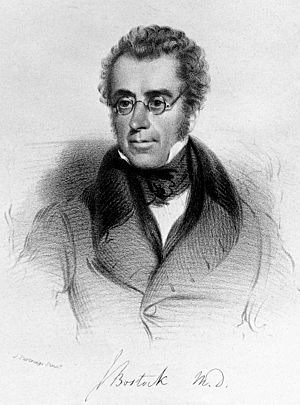John Bostock (physician) facts for kids
John Bostock, Jr. (born in 1773, died in 1846) was an important English doctor, scientist, and geologist from Liverpool. He was also a member of the Royal Society, a famous group of scientists.
A Life of Science
John Bostock, Jr. was the son of another doctor, John Bostock, Sr. Young John studied chemistry and natural philosophy (which is like early science) at New College at Hackney. He even attended lectures by a famous scientist named Joseph Priestley. After that, he earned his medical degree from the University of Edinburgh.
He started his career as a doctor in Liverpool. In 1817, he moved to London to focus more on general science. A big achievement came in 1819 when Bostock was the first to clearly describe hay fever. He explained it as a sickness that affects the nose and throat.
John Bostock also taught chemistry at Guy's Hospital. He became the President of the Geological Society of London in 1826. This was the year the society received a special Royal Charter. Later, in 1832, he became the Vice President of the Royal Society.
Sadly, Bostock died from cholera in 1846. He was buried in the Kensal Green Cemetery in London.
His Scientific Work
Bostock was one of the first "chemical pathologists." This means he studied how chemicals in the body relate to diseases. He was the first to understand an important link. He realized that when a chemical called urea decreased in urine, it increased in the blood. At the same time, when albumin decreased in the blood, it increased in the urine. This was a big step in understanding how the body works when it's sick.
His most famous book was System of Physiology, which came out in 1824. He also wrote a geology book called On the Purification of Thames Water in 1826. After he passed away, a translation he worked on was published. It was a translation of Natural History by Pliny the Elder, which he did with Henry Thomas Riley.
His Family
John Bostock married Anne Yates. They had a daughter named Elizabeth Anne Bostock in 1817. Elizabeth grew up to be very dedicated to improving education for women. John's wife, Anne, lived longer than him and passed away in 1863.


